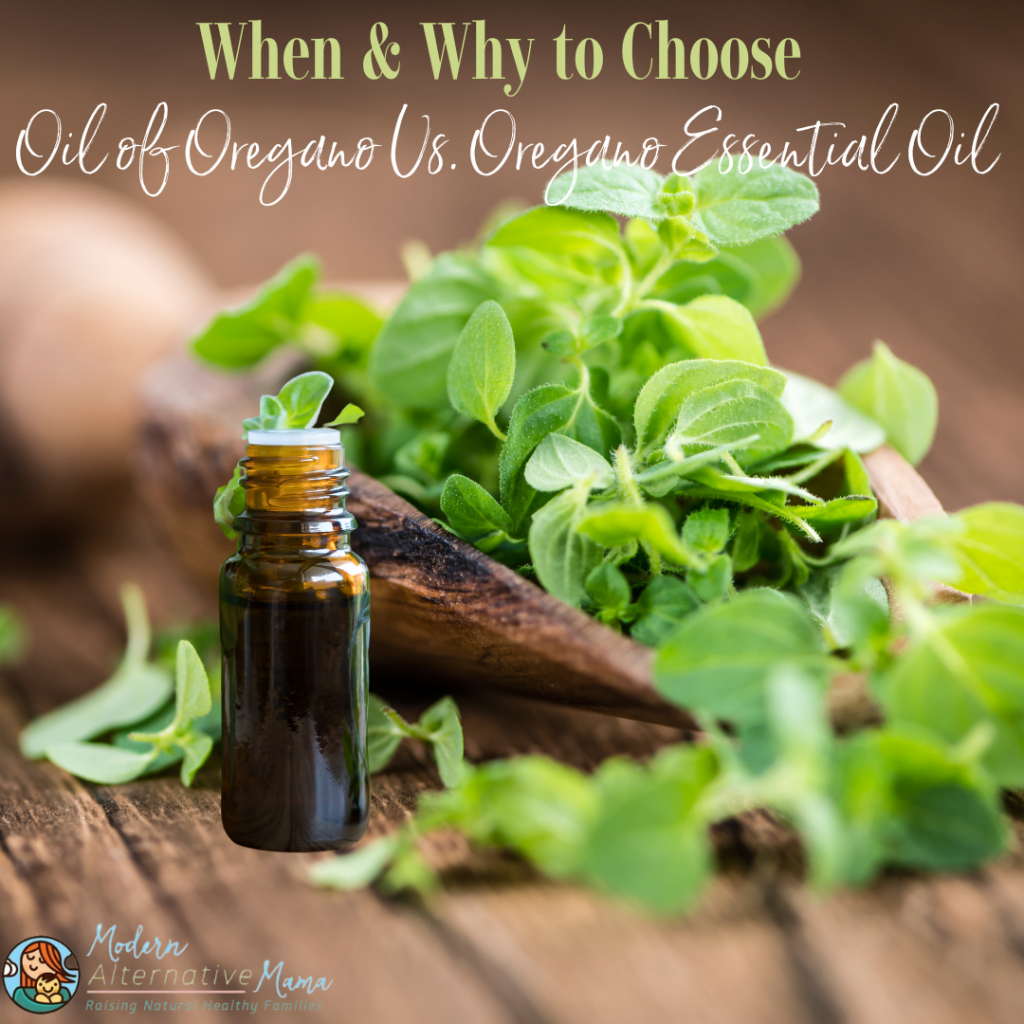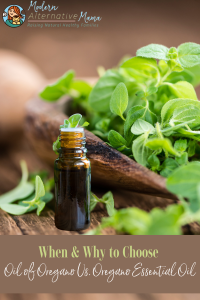Oil of Oregano vs. Oregano Essential oil
What’s the difference, and when do you use each?
Hey mama! If you’ve ever found yourself in the supplement aisle wondering whether you should grab the oil of oregano capsules or that little bottle of oregano essential oil, you are not alone. I’ve been there too—squinting at the labels and wondering which one does what, and how on earth you’re supposed to actually use them. Are they the same thing? Not quite. But they are related in a really cool way. Let’s break it down together.
So… What Is Oil of Oregano?
“Oil of Oregano” is usually what you’ll find in a capsule or liquid form at your favorite natural foods store. It’s extracted from the leaves of the oregano plant, but how it’s made can vary, and it’s good to know what you’re getting.
Here are the main ways oil of oregano is made:
- Supercritical CO2 extraction: Brands like Gaia use this. It uses carbon dioxide under just the right pressure and temperature to extract potent compounds—like carvacrol—without heat and harsh chemicals.
-It is considered one of the cleanest, most effective extraction methods.
-This method helps preserve the full spectrum of beneficial plant compounds.
-Found in many high-quality supplements (usually labeled clearly!)
- Steam distillation: This method is used to make oregano essential oil, but some companies dilute this EO in carrier oils and sell it as “oil or oregano.” It is still potent but even more concentrated and typically not recommended for internal use. Ingestion of essential oils is controversial, and some do recommend ingestion. Always check to see if your “oil or oregano” is made this way—it’ll be very potent and should be used with care. If you want something to take internally, you should use a supercritical CO2 extraction or an oregano-infused oil.
- Oregano-infused oil (herbal infusion): This is the most traditional (and most gentle) method, where dried oregano is soaked in a carrier oil like olive oil over time. You can even make this one at home! It’s not as concentrated in carvacrol, but it’s a lovely option for massage oil, gentle topical uses, and really great for cooking! It’s mild and food-friendly and very good for you, but it’s not quite the same as the supplement form.
So then… What’s oregano essential oil?
Oregano essential oil is steam distilled and very concentrated. Just one drop packs a serious punch. It’s typically used in aromatherapy, DIY cleaning blends, or (when extremely diluted) in topical applications. You do not want to take it internally unless you are working with a trained practitioner or certified aromatherapist.
-Always dilute before using topically (1 drop per tablespoon or carrier oil is a safe starting point).
-Not recommended for littles, pets, or anyone pregnant or nursing without professional guidance.
What are the benefits?
Let’s just say oregano has earned its spot in the herbal hall of fame!
– Immune support: Many natural mamas reach for oil of oregano during “cold and flu season” or when they feel something coming on!
-Antibacterial properties: Oregano is well known for its antibacterial and antifungal properties.
– Gut balance: Oregano has long been loved for its role in supporting a healthy gut microbiome and digestion.
– Antioxidant rich: The active compounds like carvacrol and thymol have been studied for their free-radical fighting properties.
– Cleansing and purifying: Oregano essential oil is often added to natural cleaning sprays, diffusers, and massage blends for its fresh, clarifying feel.
Of course, these are traditional uses, and I am not making any medical claims here, just sharing what many mamas have used in their wellness routines and how.
Is it safe during pregnancy and breastfeeding?
Here’s where we pull in a little extra caution – because that mama intuition? It matters more than ever.
– Oil of Oregano supplements (CO2 extract or EO-based): Most natural health practitioners recommend avoiding oil of oregano internally during pregnancy, especially in the first trimester. It can be quite stimulating and hasn’t been widely studied for safety during pregnancy. During breastfeeding, it’s more of a gray area. Some mamas use it under guidance in short-term, low-dose situations or just trust their gut instincts. A knowledgeable herbalist may be able to help you make the decision.
– Oregano essential oil (topical or aromatic): This is generally not recommended during pregnancy, especially in concentrated form, due to its strong potency. Even when breastfeeding, it’s wise to avoid using the EO on the chest area where the baby may come into contact. This is the gentlest form and can be a safe way to use it.
Oregano-infused oil (herbal in olive oil): enjoy the comforting aroma or mild topical benefits. It has internal benefits, too: It’s antioxidant, antifungal, good for your immune system, and much more! Try using the infused oil in a salad dressing!
As always, every mama and everybody is different. Trust your instincts, and don’t hesitate to reach out to a friend, herbalist, or trusted practitioner who understands both herbalism and motherhood.
When would you use one vs the other?
Here’s a little cheat sheet…
Oil of Oregano (capsules or diluted extract): This is great for supporting your immune system during seasonal transitions, travel, or digestive imbalances. I have also seen many people use it for sinus-related illnesses.
Oregano essential oil: This is best for external use only – cleaning sprays, diffusers, (diluted!!) massage blends.
Gentle ways to add oregano into your wellness routine
– Take oil or oregano at the onset of the sniffles.
– Add diluted extract to warm lemon water for a quick pick-me-up.
– Diffuse oregano essential oil with lemon or eucalyptus to freshen the air.
– Make a natural surface spray with oregano EO, white vinegar, and citrus.
– Use oregano-infused oil for a warming massage on sore muscles.
– Add fresh oregano or oil infused with oregano to your cooking for food as medicine goodness—something I am all about!
Final thoughts, Mama…
Oregano is one of those humble kitchen herbs that turns out to be a little herbal powerhouse. From immune support to natural home care, it’s a versatile friend to have in your toolkit, as long as you know what kind you are working with and how to use it.
And as always, in the beautiful season of pregnancy and breastfeeding, we walk gently. Nature is potent – and so are you!
Have you used oregano in your wellness routines? I’d love to hear how it supported you!
cially when practicing appropriate safety measures.
I use both of them, but not interchangeably. For instance, oil of oregano is meant to be taken internally, while oregano essential oil should never be ingested but diffused or applied topically instead. Learn more about why you should never ingest essential oils here.
For starters, oregano is an herb from the mint or Lamiaceae family. There are many different types of oregano, but Oregano vulgare, also known as Origanum, Spanish thyme, and wild marjoram, is the most commonly used in the herb world. These perennial herbs have been used for thousands of years to flavor dishes and treat health conditions in Mediterranean countries, western Asia, Greece, Italy, Mexico, and the United States (1).
Benefits of oregano include:
- Rich in antioxidants (2)
- Antibacterial properties (3)
- Antimicrobial properties (4)
- Antiviral properties (5)
- Anti-inflammatory properties (6)
- May prevent and kill certain cancers (7)
Learn more about the benefits of oregano here.
When & Why to Choose Oil of Oregano Vs. Oregano Essential Oil
Firstly, oregano’s medicinal properties stem from compounds like phenols, terpenes, and terpenoids, with powerful antioxidant properties (8):
- Carvacrol is the most abundant phenol in oregano and has been shown to stop the growth of several bacteria types (9).
- Thymol is a natural antifungal that supports the immune system and protects against toxins (10).
- Rosmarinic acid is a powerful antioxidant that helps protect against free radical damage (11).
Let’s dig into the when and why of oil of oregano versus oregano essential oil.
Oil of Oregano
Oil of oregano is made by infusing extra virgin olive oil with dried oregano leaves, creating a robust and ingestible “natural antibiotic” widely used in the natural community.
Oil of oregano can be easily made but has a 4-week waiting period before it’s ready to be used, which you can learn how to do here. Additionally, you can buy capsules and tinctures online, but be cautious about certain brands that use oregano essential oil, sometimes listed as aerial parts oil.
As per trusted aromatherapist Wendy Robbins:
“Essential oils should not be taken internally without guidance by a qualified practitioner or until you have gained adequate knowledge and understanding of the risks and safe internal applications and dosages. Even though essential oils are cold pressed or steam distilled from a range of citrus and common spices like Lemons, Oranges, Grapefruits, Allspice, Basil, Black Pepper, Cinnamon, Clove, Fennel, Ginger, Rosemary and a number of other botanicals that are routinely ingested without the need for precautionary usage info, essential oils are highly concentrated and should not be ingested without thorough understanding of appropriate usage and risks for each oil (12).”
Instead, opt for something like Gaia’s Oil of Oregano Capsules or Garden of Life’s Oil of Oregano Drops. Both are great options the next time you’re trying to support your body during infection, cancer treatments, or any other time your immune system is struggling. I recommend using oil of oregano for a maximum of 2-4 weeks at a time.
Oregano Essential Oil
Contrarily, oregano essential oil is meant to be applied topically or diffused in the air. In some instances, you can find recipes for homemade mouthwashes, such as this , which is beneficial for tooth inflammation and infections, but you should never swallow the mouthwash.
According to aromatherapist Wendy Robbins, essential oils should never be taken internally or applied undiluted. Oregano essential oil should be diluted at the recommended dermal maximum of 1.1%. There are indications that oregano essential oil may cause embryotoxicity and a moderate risk of skin sensitization (13).
I highly recommend Plant Therapy’s Organic Oregano Essential Oil, but keep in mind it is not safe for children or pets or during pregnancy and breastfeeding.
You can use oregano essential oil topically, never neat (undiluted), for fungal and bacterial infections or diffuse it for respiratory benefits such as easing coughs and congestion.







